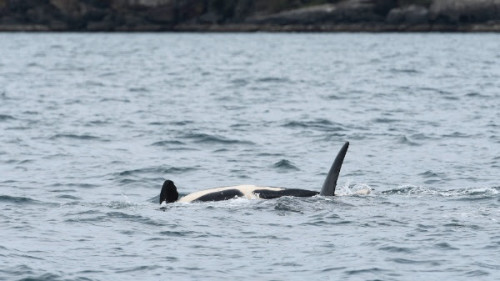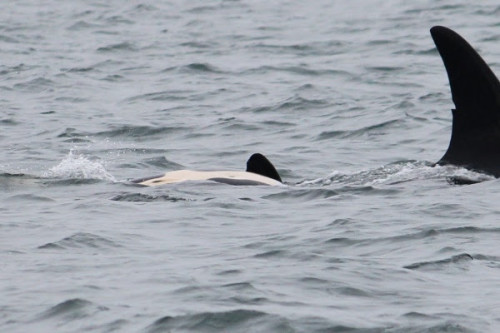J54 has been confirmed male based on recent photographs taken by local Naturalists.
— from Center for Whale Research —

J54 confirmed male- Photo by Heather Macintyre
We have suspected that J54 is a male for several months but have been unable to get a conclusive photograph of the calf’s underbelly to confirm the calf’s sex until this week. On March 21, Center for Whale Research volunteer and local naturalist, Melisa Pinnow, captured an image of the young male calf’s belly and yesterday we received another clear photograph from naturalist Heather Macintyre that confirms J54 is male.
The news of yet another male in the baby-boom cohort is some cause for concern that the recent baby boom is not necessarily indicative of a recovery. There are currently eight remaining calves born between December 30 2014 and January 18 2016 and only one animal is known to be a female – J50, who was the first of the “baby boom” calves to be born.
Of the remaining seven calves, five are known to be male, one more is suspected to be male, and the sex of the last calf is completely unknown at this point. From a population perspective this sex ratio does not bode well for the growth of the SRKW community because there is only one female within this age class who can get pregnant and increase the population.
Given that female killer whales don’t tend to given birth until after the age of ten and are only able to give birth roughly every three years it is not hard to see how slowly the population will grow when this cohort of animals reaches breeding age.

J54 with J28- Photo by Melisa Pinnow
Recent studies in other mammals have shown skewed sex ratios related to exposure to toxins; this may be of concern for the southern residents too. More studies on the effects of toxins in the ecosystem are needed immediately to better understand the implications for the recovery of the Southern Resident killer whale population.
**If you are reading theOrcasonian for free, thank your fellow islanders. If you would like to support theOrcasonian CLICK HERE to set your modestly-priced, voluntary subscription. Otherwise, no worries; we’re happy to share with you.**







